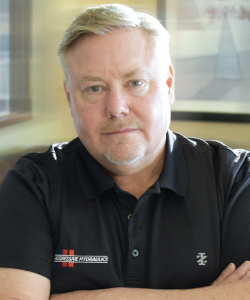Infuse Value Proposition into Your Company’s DNA
 By Paul Johnson, President, Aggressive Hydraulics
By Paul Johnson, President, Aggressive Hydraulics
In this day and age of Amazon and Omnichannel for retail, we are becoming conditioned to buy differently while getting the best pricing available. Beyond pricing, we want the experience to be easy. You don’t have to go to the store because delivery to your home is common, and in many cases the shipping is free. Department-store chains have built multimillion-square-foot fulfillment centers to support their online shopping platforms. If fast food is not convenient enough, you can have DoorDash deliver your meal for a modest fee. If you don’t have time to grocery shop, you can use Instacart.
How are these trends in retail affecting fluid power supply chains? Business dynamics are changing, and manufacturing suppliers, regardless of the industry, must change to adapt to customer demand for improved experience. Downward pricing pressure is always present. In some cases, the initiatives pursuant to managing a vendor’s products can tend to commoditize everything. By definition, a commodity is the market treating the good as equivalent or nearly so, with no regard to who produced it.
How do your customers view your company as part of their supply chain? Are you the supplier that provides the cheapest price? Are you viewed as a commodity? Hopefully you’re providing a value proposition that is aligned with what your customers need and want. A hydraulic component can be defined by category or class, but when your products are defined or viewed as a commodity, it is problematic. What about the company that produces it? This is when differentiation of the company and the product becomes imperative.
The company
Companies are challenged to create a value proposition that will continue to deliver products and services that meet customer expectations in an ever-changing landscape. Is your value proposition a reflection of your company or of your products and services? A value proposition is much like a warranty; it is only as good as the company that stands behind it. A good value proposition should not be aspirational; it should be something ingrained in the DNA of the company culture and every employee within the organization.
Aggressive Hydraulics has embraced the tools found in the Entrepreneurial Operating System (EOS) described in the book “Traction,” by Gino Wickman. EOS aligns our employees and focuses our efforts on the right things. For example, we have defined our Three Uniques that we believe set us apart from others in our industry. They are the heart of the value proposition our company offers to our customers. They are unchanged by customer situations, market trends, or the economic landscape. All employees know our Three Uniques, which are part of our culture.
The product or service
In addition to differentiating your company, it is also advantageous to differentiate your products or services. This has always been a challenge, but is even more important in our rapidly changing market, which is influenced by today’s retail trends and the social and economic impact of the pandemic. If your product is considered a commodity by the market, customers will consider price first when selecting a supplier. In contrast, a sales transaction based on value flows from collaborative discussions between supplier and customer regarding productivity, reliability, and durability. This can lead to breakthrough technology that radically changes the way work is done. It can also lead to multiple incremental changes with a greater aggregate impact than a single breakthrough technology. For the sustainability of your customer relationship, your product or service value needs to be evident and acknowledged before, during, and after the sale.
Upon inception, Aggressive Hydraulics made the conscious decision to not provide commodity products. Our hydraulic cylinders are built to order, operating on every continent, and are typically in applications supporting essential services and infrastructure. To ensure our products work as intended in demanding applications, we have a process that goes beyond custom, so we use the term purpose-built. A custom product can be a pre-engineered or predesigned product that is modified to fit an application in terms of fit, form, and function. But these products are not necessarily engineered and designed specifically for the intended application. When our sales, engineering, and manufacturing teams develop and manufacture a purpose-built product, we use another EOS tool called proven process. This is our method to consistently create successful purpose-built hydraulic cylinders for our customers, from initial gathering and understanding requirements to final delivery of the product and providing ongoing support.
Consider leveraging your internal processes, tools, and culture to provide differentiation and value selling, resulting in a positive experience for your customers and prospects. Never lose sight of your value proposition and stand behind it.







